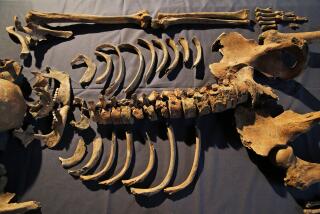Developments in Brief : 11,500-Year-Old Bear Bones Indicate Syphilis
- Share via
The 11,500-year-old bones of a bear from the Midwest indicate the animal may have died of syphilis, the earliest evidence of the disease ever uncovered in North America, scientists say.
The discovery adds fuel to the debate over the origins of the sexually transmitted disease, which some believe was introduced into Europe from North America by the crew of Christopher Columbus.
The bones, found in Indiana several years ago, had lesions and holes characteristic of syphilis, which can attack skin, bones and vital organs, according to Dr. Bruce Rothschild, professor of medicine at Northeast Ohio University’s College of Medicine.
He said the bones tested positive for an antigen from the bacteria known to cause the disease. Antigens are substances foreign to the body, often proteins, which may be left behind by invading organisms.
“The bones had all the characteristics of syphilis,” Rothschild, an expert in the history of disease, said in last week’s Nature magazine. He said it is possible for humans and animals to share viral and bacterial diseases, and a number of mammals are known to get syphilis.
Rothschild said scholars believe a syphilis epidemic in Europe in the early 16th Century was triggered by the return of Columbus’s crew from North America, where many believe the disease originated.
Previously, scientists have found evidence of syphilis in the bones of humans that lived 1,000 to 3,000 years ago in North America, but the new discovery is by far the oldest sign of the disease.
More to Read
Sign up for Essential California
The most important California stories and recommendations in your inbox every morning.
You may occasionally receive promotional content from the Los Angeles Times.













